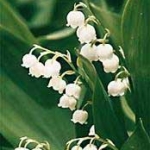Convallaria majalis

These little white bell-shaped blossoms perched atop delicate stems, sometimes called our lady’s tears, were first cultivated in 1420 and are often used in weddings, signifying “a return to happiness”. Because lily-of-the-valley contains cardiac glycosides, it has been used as a cardiac tonic to slow the action of a weak, irritable heart, while simultaneously increasing its power.
Creeping perennial with branched rhizomes, and pairs of ovate to elliptic leaves, 4-20cm (1½-8in) long. Arching racemes of 5-13 white, fragrant, bell-shaped flowers, about 6mm (¼in) across and waxy in texture, appear in spring, followed by globose, red berries.
Has golden stripes down the leaves. Tends to revert if grown in deep shade. Flore Pleno Fortin’s Giant Hardwick Hall Prolificans Var. rosea | |
To treat stroke, leprosy, heart problems, and epilepsy. Germany’s Commission E has approved the use of lily-of-the-valley to treat irregular heartbeat and other heart ailments. | |
- Increased risk of cardiac glycoside toxicity when used with other herbs that contain cardiac glycosides, such as Black Hellebore, Calatropis, Motherwort, and others.
- Increased risk of potassium depletion when used in conjunction with Horsetail Plant or Licorice.
- Increased risk of cardiotoxicity due to potassium depletion when taken with cardioactive herbs, such as Adonis, Digitalis, and Squill.
- Increased risk of potassium depletion when used with stimulant laxative herbs, such as Black Root, Cascara Sagrada, Castor Oil, and Senna.
- Increased action of lily-of-the-valley when taken concurrently with English Hawthorn.
All parts, especially fruits and seeds, are toxic if eaten.
The Essential Herb-Drug-Vitamin Interaction Guide by Geo. T. Grossberg,MD and Barry Fox,PhD Copyright©2007 Barry Fox,PhD. Pp.312-314
